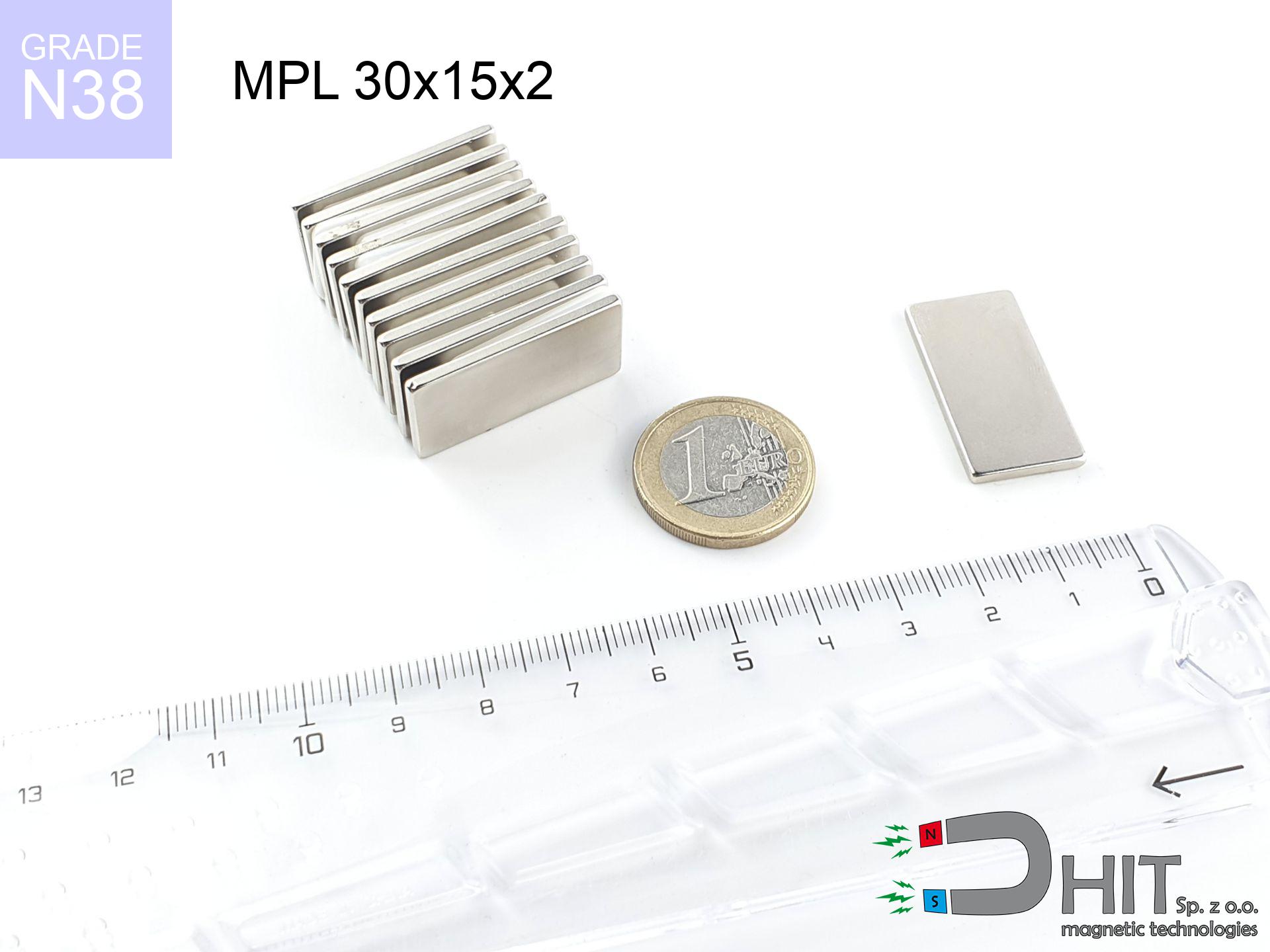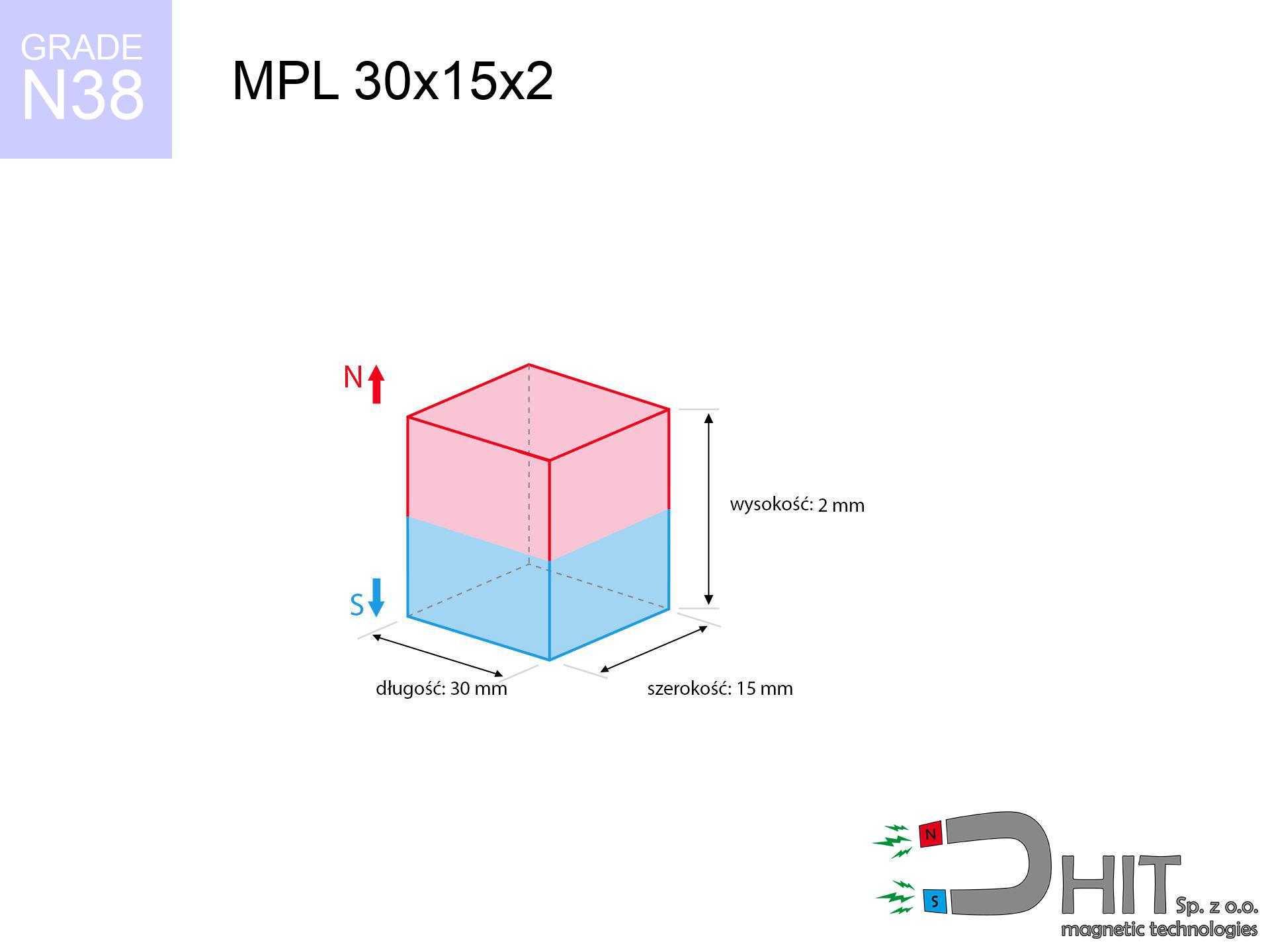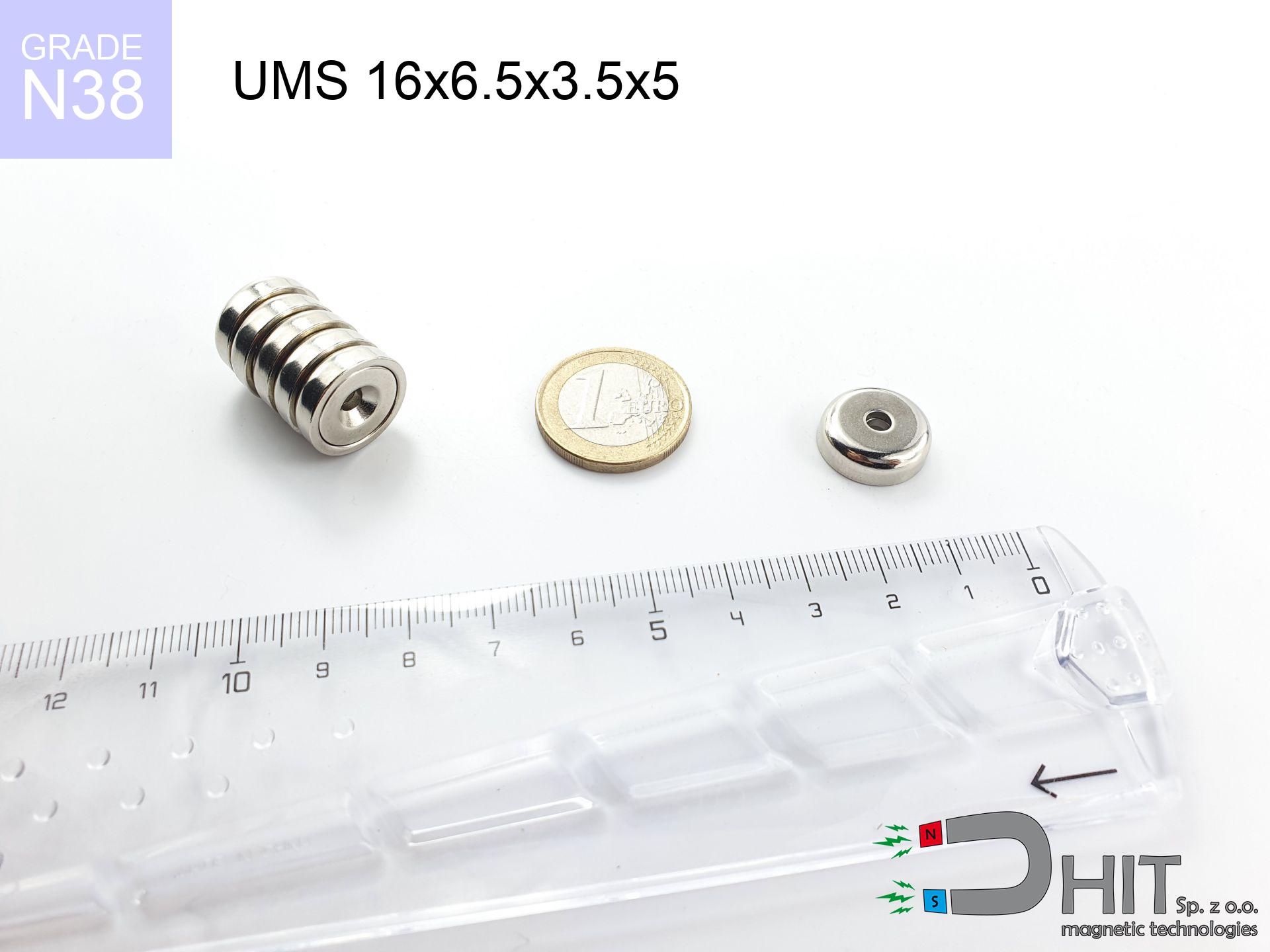MPL 30x15x2 / N38 - lamellar magnet
lamellar magnet
Catalog no 020140
GTIN/EAN: 5906301811466
length
30 mm [±0,1 mm]
Width
15 mm [±0,1 mm]
Height
2 mm [±0,1 mm]
Weight
6.75 g
Magnetization Direction
↑ axial
Load capacity
2.11 kg / 20.74 N
Magnetic Induction
115.11 mT / 1151 Gs
Coating
[NiCuNi] Nickel
3.89 ZŁ with VAT / pcs + price for transport
3.16 ZŁ net + 23% VAT / pcs
bulk discounts:
Need more?
Call us
+48 22 499 98 98
or contact us via
our online form
the contact form page.
Specifications as well as form of magnetic components can be verified using our
magnetic calculator.
Same-day shipping for orders placed before 14:00.
Technical specification of the product - MPL 30x15x2 / N38 - lamellar magnet
Specification / characteristics - MPL 30x15x2 / N38 - lamellar magnet
| properties | values |
|---|---|
| Cat. no. | 020140 |
| GTIN/EAN | 5906301811466 |
| Production/Distribution | Dhit sp. z o.o. |
| Country of origin | Poland / China / Germany |
| Customs code | 85059029 |
| length | 30 mm [±0,1 mm] |
| Width | 15 mm [±0,1 mm] |
| Height | 2 mm [±0,1 mm] |
| Weight | 6.75 g |
| Magnetization Direction | ↑ axial |
| Load capacity ~ ? | 2.11 kg / 20.74 N |
| Magnetic Induction ~ ? | 115.11 mT / 1151 Gs |
| Coating | [NiCuNi] Nickel |
| Manufacturing Tolerance | ±0.1 mm |
Magnetic properties of material N38
| properties | values | units |
|---|---|---|
| remenance Br [min. - max.] ? | 12.2-12.6 | kGs |
| remenance Br [min. - max.] ? | 1220-1260 | mT |
| coercivity bHc ? | 10.8-11.5 | kOe |
| coercivity bHc ? | 860-915 | kA/m |
| actual internal force iHc | ≥ 12 | kOe |
| actual internal force iHc | ≥ 955 | kA/m |
| energy density [min. - max.] ? | 36-38 | BH max MGOe |
| energy density [min. - max.] ? | 287-303 | BH max KJ/m |
| max. temperature ? | ≤ 80 | °C |
Physical properties of sintered neodymium magnets Nd2Fe14B at 20°C
| properties | values | units |
|---|---|---|
| Vickers hardness | ≥550 | Hv |
| Density | ≥7.4 | g/cm3 |
| Curie Temperature TC | 312 - 380 | °C |
| Curie Temperature TF | 593 - 716 | °F |
| Specific resistance | 150 | μΩ⋅cm |
| Bending strength | 250 | MPa |
| Compressive strength | 1000~1100 | MPa |
| Thermal expansion parallel (∥) to orientation (M) | (3-4) x 10-6 | °C-1 |
| Thermal expansion perpendicular (⊥) to orientation (M) | -(1-3) x 10-6 | °C-1 |
| Young's modulus | 1.7 x 104 | kg/mm² |
Physical modeling of the magnet - data
The following data are the outcome of a engineering analysis. Values are based on algorithms for the material Nd2Fe14B. Actual performance might slightly differ from theoretical values. Use these calculations as a reference point during assembly planning.
Table 1: Static pull force (pull vs distance) - power drop
MPL 30x15x2 / N38
| Distance (mm) | Induction (Gauss) / mT | Pull Force (kg) | Risk Status |
|---|---|---|---|
| 0 mm |
1151 Gs
115.1 mT
|
2.11 kg / 2110.0 g
20.7 N
|
strong |
| 1 mm |
1098 Gs
109.8 mT
|
1.92 kg / 1920.5 g
18.8 N
|
weak grip |
| 2 mm |
1019 Gs
101.9 mT
|
1.65 kg / 1654.9 g
16.2 N
|
weak grip |
| 3 mm |
926 Gs
92.6 mT
|
1.37 kg / 1365.9 g
13.4 N
|
weak grip |
| 5 mm |
733 Gs
73.3 mT
|
0.86 kg / 855.2 g
8.4 N
|
weak grip |
| 10 mm |
379 Gs
37.9 mT
|
0.23 kg / 228.8 g
2.2 N
|
weak grip |
| 15 mm |
203 Gs
20.3 mT
|
0.07 kg / 65.6 g
0.6 N
|
weak grip |
| 20 mm |
116 Gs
11.6 mT
|
0.02 kg / 21.6 g
0.2 N
|
weak grip |
| 30 mm |
46 Gs
4.6 mT
|
0.00 kg / 3.4 g
0.0 N
|
weak grip |
| 50 mm |
12 Gs
1.2 mT
|
0.00 kg / 0.2 g
0.0 N
|
weak grip |
Table 2: Vertical force (vertical surface)
MPL 30x15x2 / N38
| Distance (mm) | Friction coefficient | Pull Force (kg) |
|---|---|---|
| 0 mm | Stal (~0.2) |
0.42 kg / 422.0 g
4.1 N
|
| 1 mm | Stal (~0.2) |
0.38 kg / 384.0 g
3.8 N
|
| 2 mm | Stal (~0.2) |
0.33 kg / 330.0 g
3.2 N
|
| 3 mm | Stal (~0.2) |
0.27 kg / 274.0 g
2.7 N
|
| 5 mm | Stal (~0.2) |
0.17 kg / 172.0 g
1.7 N
|
| 10 mm | Stal (~0.2) |
0.05 kg / 46.0 g
0.5 N
|
| 15 mm | Stal (~0.2) |
0.01 kg / 14.0 g
0.1 N
|
| 20 mm | Stal (~0.2) |
0.00 kg / 4.0 g
0.0 N
|
| 30 mm | Stal (~0.2) |
0.00 kg / 0.0 g
0.0 N
|
| 50 mm | Stal (~0.2) |
0.00 kg / 0.0 g
0.0 N
|
Table 3: Wall mounting (sliding) - vertical pull
MPL 30x15x2 / N38
| Surface type | Friction coefficient / % Mocy | Max load (kg) |
|---|---|---|
| Raw steel |
µ = 0.3
30% Nominalnej Siły
|
0.63 kg / 633.0 g
6.2 N
|
| Painted steel (standard) |
µ = 0.2
20% Nominalnej Siły
|
0.42 kg / 422.0 g
4.1 N
|
| Oily/slippery steel |
µ = 0.1
10% Nominalnej Siły
|
0.21 kg / 211.0 g
2.1 N
|
| Magnet with anti-slip rubber |
µ = 0.5
50% Nominalnej Siły
|
1.06 kg / 1055.0 g
10.3 N
|
Table 4: Steel thickness (saturation) - sheet metal selection
MPL 30x15x2 / N38
| Steel thickness (mm) | % power | Real pull force (kg) |
|---|---|---|
| 0.5 mm |
|
0.21 kg / 211.0 g
2.1 N
|
| 1 mm |
|
0.53 kg / 527.5 g
5.2 N
|
| 2 mm |
|
1.06 kg / 1055.0 g
10.3 N
|
| 5 mm |
|
2.11 kg / 2110.0 g
20.7 N
|
| 10 mm |
|
2.11 kg / 2110.0 g
20.7 N
|
Table 5: Thermal stability (stability) - thermal limit
MPL 30x15x2 / N38
| Ambient temp. (°C) | Power loss | Remaining pull | Status |
|---|---|---|---|
| 20 °C | 0.0% |
2.11 kg / 2110.0 g
20.7 N
|
OK |
| 40 °C | -2.2% |
2.06 kg / 2063.6 g
20.2 N
|
OK |
| 60 °C | -4.4% |
2.02 kg / 2017.2 g
19.8 N
|
|
| 80 °C | -6.6% |
1.97 kg / 1970.7 g
19.3 N
|
|
| 100 °C | -28.8% |
1.50 kg / 1502.3 g
14.7 N
|
Table 6: Two magnets (repulsion) - forces in the system
MPL 30x15x2 / N38
| Gap (mm) | Attraction (kg) (N-S) | Repulsion (kg) (N-N) |
|---|---|---|
| 0 mm |
3.67 kg / 3675 g
36.1 N
2 169 Gs
|
N/A |
| 1 mm |
3.53 kg / 3533 g
34.7 N
2 257 Gs
|
3.18 kg / 3180 g
31.2 N
~0 Gs
|
| 2 mm |
3.34 kg / 3345 g
32.8 N
2 196 Gs
|
3.01 kg / 3010 g
29.5 N
~0 Gs
|
| 3 mm |
3.12 kg / 3124 g
30.6 N
2 122 Gs
|
2.81 kg / 2812 g
27.6 N
~0 Gs
|
| 5 mm |
2.63 kg / 2631 g
25.8 N
1 948 Gs
|
2.37 kg / 2368 g
23.2 N
~0 Gs
|
| 10 mm |
1.49 kg / 1490 g
14.6 N
1 465 Gs
|
1.34 kg / 1341 g
13.2 N
~0 Gs
|
| 20 mm |
0.40 kg / 398 g
3.9 N
758 Gs
|
0.36 kg / 359 g
3.5 N
~0 Gs
|
| 50 mm |
0.01 kg / 14 g
0.1 N
142 Gs
|
0.01 kg / 13 g
0.1 N
~0 Gs
|
Table 7: Protective zones (electronics) - precautionary measures
MPL 30x15x2 / N38
| Object / Device | Limit (Gauss) / mT | Safe distance |
|---|---|---|
| Pacemaker | 5 Gs (0.5 mT) | 7.0 cm |
| Hearing aid | 10 Gs (1.0 mT) | 5.5 cm |
| Timepiece | 20 Gs (2.0 mT) | 4.5 cm |
| Mobile device | 40 Gs (4.0 mT) | 3.5 cm |
| Car key | 50 Gs (5.0 mT) | 3.0 cm |
| Payment card | 400 Gs (40.0 mT) | 1.0 cm |
| HDD hard drive | 600 Gs (60.0 mT) | 1.0 cm |
Table 8: Collisions (cracking risk) - collision effects
MPL 30x15x2 / N38
| Start from (mm) | Speed (km/h) | Energy (J) | Predicted outcome |
|---|---|---|---|
| 10 mm |
19.00 km/h
(5.28 m/s)
|
0.09 J | |
| 30 mm |
30.91 km/h
(8.59 m/s)
|
0.25 J | |
| 50 mm |
39.87 km/h
(11.08 m/s)
|
0.41 J | |
| 100 mm |
56.39 km/h
(15.66 m/s)
|
0.83 J |
Table 9: Anti-corrosion coating durability
MPL 30x15x2 / N38
| Technical parameter | Value / Description |
|---|---|
| Coating type | [NiCuNi] Nickel |
| Layer structure | Nickel - Copper - Nickel |
| Layer thickness | 10-20 µm |
| Salt spray test (SST) ? | 24 h |
| Recommended environment | Indoors only (dry) |
Table 10: Construction data (Flux)
MPL 30x15x2 / N38
| Parameter | Value | SI Unit / Description |
|---|---|---|
| Magnetic Flux | 6 236 Mx | 62.4 µWb |
| Pc Coefficient | 0.13 | Low (Flat) |
Table 11: Submerged application
MPL 30x15x2 / N38
| Environment | Effective steel pull | Effect |
|---|---|---|
| Air (land) | 2.11 kg | Standard |
| Water (riverbed) |
2.42 kg
(+0.31 kg Buoyancy gain)
|
+14.5% |
1. Vertical hold
*Warning: On a vertical surface, the magnet retains only approx. 20-30% of its nominal pull.
2. Steel saturation
*Thin steel (e.g. 0.5mm PC case) significantly reduces the holding force.
3. Power loss vs temp
*For standard magnets, the max working temp is 80°C.
4. Demagnetization curve and operating point (B-H)
chart generated for the permeance coefficient Pc (Permeance Coefficient) = 0.13
The chart above illustrates the magnetic characteristics of the material within the second quadrant of the hysteresis loop. The solid red line represents the demagnetization curve (material potential), while the dashed blue line is the load line based on the magnet's geometry. The Pc (Permeance Coefficient), also known as the load line slope, is a dimensionless value that describes the relationship between the magnet's shape and its magnetic stability. The intersection of these two lines (the black dot) is the operating point — it determines the actual magnetic flux density generated by the magnet in this specific configuration. A higher Pc value means the magnet is more 'slender' (tall relative to its area), resulting in a higher operating point and better resistance to irreversible demagnetization caused by external fields or temperature. A value of 0.42 is relatively low (typical for flat magnets), meaning the operating point is closer to the 'knee' of the curve — caution is advised when operating at temperatures near the maximum limit to avoid strength loss.
Elemental analysis
| iron (Fe) | 64% – 68% |
| neodymium (Nd) | 29% – 32% |
| boron (B) | 1.1% – 1.2% |
| dysprosium (Dy) | 0.5% – 2.0% |
| coating (Ni-Cu-Ni) | < 0.05% |
Ecology and recycling (GPSR)
| recyclability (EoL) | 100% |
| recycled raw materials | ~10% (pre-cons) |
| carbon footprint | low / zredukowany |
| waste code (EWC) | 16 02 16 |
Other products
Strengths as well as weaknesses of rare earth magnets.
Benefits
- They do not lose magnetism, even after nearly ten years – the drop in lifting capacity is only ~1% (according to tests),
- Neodymium magnets are characterized by exceptionally resistant to demagnetization caused by external interference,
- In other words, due to the metallic finish of gold, the element gains visual value,
- Magnets possess excellent magnetic induction on the surface,
- Through (adequate) combination of ingredients, they can achieve high thermal strength, allowing for operation at temperatures approaching 230°C and above...
- Considering the possibility of accurate shaping and adaptation to specialized projects, NdFeB magnets can be modeled in a wide range of forms and dimensions, which expands the range of possible applications,
- Versatile presence in modern technologies – they find application in data components, drive modules, medical devices, also multitasking production systems.
- Compactness – despite small sizes they offer powerful magnetic field, making them ideal for precision applications
Disadvantages
- At very strong impacts they can crack, therefore we advise placing them in special holders. A metal housing provides additional protection against damage, as well as increases the magnet's durability.
- NdFeB magnets lose strength when exposed to high temperatures. After reaching 80°C, many of them experience permanent weakening of strength (a factor is the shape as well as dimensions of the magnet). We offer magnets specially adapted to work at temperatures up to 230°C marked [AH], which are extremely resistant to heat
- Due to the susceptibility of magnets to corrosion in a humid environment, we recommend using waterproof magnets made of rubber, plastic or other material resistant to moisture, in case of application outdoors
- Limited ability of creating threads in the magnet and complex forms - preferred is cover - magnet mounting.
- Potential hazard to health – tiny shards of magnets are risky, when accidentally swallowed, which is particularly important in the context of child safety. It is also worth noting that small components of these magnets are able to complicate diagnosis medical in case of swallowing.
- With mass production the cost of neodymium magnets is economically unviable,
Holding force characteristics
Best holding force of the magnet in ideal parameters – what contributes to it?
- with the use of a sheet made of low-carbon steel, ensuring full magnetic saturation
- with a cross-section of at least 10 mm
- with an polished touching surface
- under conditions of no distance (metal-to-metal)
- under axial force vector (90-degree angle)
- at room temperature
Practical aspects of lifting capacity – factors
- Gap between surfaces – even a fraction of a millimeter of separation (caused e.g. by varnish or unevenness) diminishes the magnet efficiency, often by half at just 0.5 mm.
- Load vector – highest force is obtained only during perpendicular pulling. The force required to slide of the magnet along the plate is standardly several times smaller (approx. 1/5 of the lifting capacity).
- Wall thickness – thin material does not allow full use of the magnet. Part of the magnetic field penetrates through instead of converting into lifting capacity.
- Material composition – not every steel reacts the same. Alloy additives weaken the interaction with the magnet.
- Surface structure – the more even the surface, the better the adhesion and higher the lifting capacity. Roughness creates an air distance.
- Temperature – temperature increase causes a temporary drop of force. It is worth remembering the maximum operating temperature for a given model.
Lifting capacity testing was carried out on a smooth plate of suitable thickness, under a perpendicular pulling force, whereas under shearing force the load capacity is reduced by as much as fivefold. Moreover, even a slight gap between the magnet and the plate lowers the load capacity.
Warnings
Implant safety
Health Alert: Neodymium magnets can deactivate pacemakers and defibrillators. Stay away if you have electronic implants.
Skin irritation risks
It is widely known that the nickel plating (standard magnet coating) is a strong allergen. If your skin reacts to metals, prevent touching magnets with bare hands and opt for coated magnets.
Electronic devices
Very strong magnetic fields can erase data on credit cards, hard drives, and other magnetic media. Stay away of min. 10 cm.
Finger safety
Big blocks can break fingers instantly. Under no circumstances put your hand betwixt two strong magnets.
Permanent damage
Standard neodymium magnets (grade N) undergo demagnetization when the temperature surpasses 80°C. Damage is permanent.
Precision electronics
Navigation devices and mobile phones are highly susceptible to magnetism. Close proximity with a strong magnet can permanently damage the sensors in your phone.
Keep away from children
These products are not toys. Accidental ingestion of a few magnets may result in them attracting across intestines, which constitutes a severe health hazard and necessitates urgent medical intervention.
Flammability
Machining of neodymium magnets carries a risk of fire risk. Neodymium dust oxidizes rapidly with oxygen and is hard to extinguish.
Material brittleness
NdFeB magnets are sintered ceramics, meaning they are prone to chipping. Clashing of two magnets leads to them shattering into shards.
Handling guide
Before use, read the rules. Sudden snapping can destroy the magnet or hurt your hand. Think ahead.




![UMP 94x28 [3xM10] GW F300 GOLD Lina / N38 - search holder UMP 94x28 [3xM10] GW F300 GOLD Lina / N38 - search holder](https://cdn3.dhit.pl/graphics/products/ump-94x28-m10-gw-f300-+lina-kac.jpg)


![SM 25x350 [2xM8] / N52 - magnetic separator SM 25x350 [2xM8] / N52 - magnetic separator](https://cdn3.dhit.pl/graphics/products/sm-25x350-2xm8-geb.jpg)

